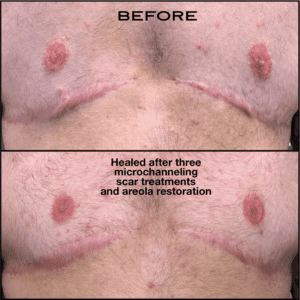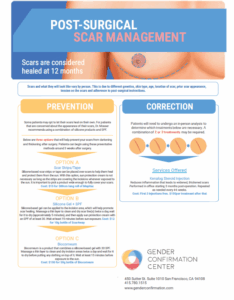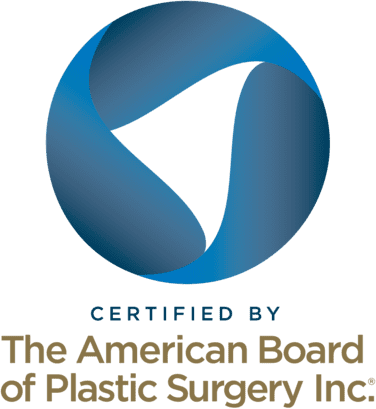Scar Care After Gender Confirmation Surgery
What is a Scar?
Scarring is the body’s natural response to repairing a trauma to the skin, be it from an injury, a burn, an infection, or surgery. In response to damage caused to the dermis, the deeper layer of skin, the body creates fibrous tissue to repair and close up these openings. The healing process involves collagen production, which gives structural support and helps your tissue regenerate.
Initially, scar tissue may appear raised and thick in shades of pink, red, or purple. However, with time, scars usually change in color and texture, becoming less noticeable. Patients who carefully follow scar treatment and care protocols tend to have better healing outcomes.
Scar Care: Prevention
Proactive scar management can make a major difference in preventing discoloration and reducing the texture of scars if desired. Early intervention significantly affects how scars heal and reduces visibility over time. Even for patients who prefer to have visible scars, consistent scar massage is still recommended to reduce fibrosis and prevent any complications like chronic pain.
-
- Tobacco Consumption: If you currently smoke, avoiding tobacco use for at least 3-6 weeks before and after surgery is one of the easiest ways to improve your body’s healing response.
- Dietary Changes: Eating a nutritious diet containing adequate protein, zinc, and vitamin C has been clinically proven to accelerate healing. This is a step you can take even before your procedure.
- SPF and Topical Treatments: Following surgery, it is important to keep your scars out of the sun (or wear sunscreen with at least 30 SPF) for at least one year. Over-the-counter topical treatments like Scarguard and Bio-Oil have been shown to speed up wound healing and improve the appearance of scars.
- Scar Massage: 3 weeks post-surgery, you can start massaging your scars. We recommend that patients massage their scars with Bio oil during the first three months after surgery.
- Silicone Therapy, Compression, and Moisture: Silicone scar cream, sheets, or compression tape creates a moist environment that prevents excessive collagen buildup. This is recommended to be applied consistently starting 3 weeks after surgery, regardless of skin type.
- Infection Prevention: To minimize the risk of infection, keep the surgical site clean and dry, follow your surgeon’s aftercare instructions diligently, and monitor for any signs of infection, such as fevers, increased redness, swelling, or discharge.
Scar Complications: Keloid, Hypertrophic, Atrophic, & Hypopigmented Scars
Factors such as pigmentation, skin type, and genetics can influence the development and appearance of scars. These factors also increase the likelihood of developing keloid or hypertrophic scars. Bodily and dietary functions also come into play, including the duration of our inflammatory response and the natural speed at which our wounds heal; all of these elements shape the final characteristics of each scar. There is no definitive way to prevent these complications, but your surgeon will be able to discuss possible treatments should these arise.
Scarring complications may include:
-
- Hypertrophic scars are what we call scars that develop a thick, ropy texture as a result of tissue buildup or fibrosis. They are slightly raised and red.
- Keloid scars are thick, raised scars that extend beyond the incision site. They are rarer than hypertrophic scars, and unlike a simple hypertrophic pattern, keloid scars thicken and grow into the surrounding healthy tissue.
- Atrophic scars are those with a sunken appearance. Since the body is unable to regenerate the tissue, an indent is left behind. This is more common in patients with severe acne than as an outcome of surgery.
- Hyperpigmented and hypopigmented scars are two types of scar discoloration. Hyperpigmented scars are darker than the surrounding area’s skin tone, whereas hypopigmented scars have less melanin than the surrounding skin. Hypopigmented scars are more common in patients with richer or darker skin tones.
Treatment and Prevention: Surgical Considerations for Keloid Scars and Hypertrophic Scarring
Treatments and Revisions for Scar Complications
Topical Treatments for Scar Healing
Topical treatments are a popular method for scar healing because they create a barrier on the skin that locks in moisture. The added hydration supports fibroblasts, cells that heal wounds and produce collagen. This protective barrier also keeps delicate scar tissue free from debris and bacteria. It helps soften the texture of scars, flatten raised areas, and reduce redness and discoloration.
- Silicone Scar Therapy: Silicone-based treatments, such as sheets and gels, are effective in improving the appearance of scars after surgery. With regular use, silicone can also relieve the itching, pain, and discomfort often associated with scars. If you are looking to enhance the appearance of your scars, silicone treatments may be an excellent option.
- Over-the-Counter Ointments: When choosing medical-grade scar creams and ointments, it is helpful to look for key ingredients such as vitamin C, onion extract, and peptides to help improve the skin’s appearance. Vitamin C helps brighten discoloration and supports collagen production. Onion extract effectively reduces inflammation and redness, while peptides promote skin regeneration.
- Prescription Scar Treatments: If you have painful scars that limit your movement or simply haven’t improved with over-the-counter options, you may consider a prescription scar treatment. For instance, corticosteroids can reduce inflammation and help flatten raised scars like keloids. Retinoids, such as tretinoin, are also beneficial as they promote skin cell turnover and enhance the texture of scars. Again, checking in with a healthcare provider to see what other options might work best for you is always a good idea.
Many reputable over-the-counter brands offer silicone-based scar treatments. Selecting the right product depends on the type of scar you have and your individual needs, so seeking advice from a healthcare professional can be very beneficial.
- ScarAway provides silicone sheets and gels designed specifically for surgical scars.
- Kelo-cote is known for its self-drying silicone gel, which creates a waterproof layer.
- BioCorneum offers a highly absorbable formulation as well as SPF protection, making it ideal for scars exposed to sunlight.
Natural Remedies for Scar Care
For those exploring a more natural approach, aloe vera and honey may offer potential benefits for scar care. Aloe vera is a natural alternative well-known for its soothing and anti-inflammatory properties, which can help reduce redness and promote skin healing. Honey possesses antimicrobial and wound-healing properties that aid in tissue repair. While vitamin E is commonly used to improve skin texture and elasticity, its benefits for scar treatment are not well established.
Advanced Medical Scar Treatments
If topical treatments are not helpful, several other treatments can improve the appearance of scars once fully healed. It is advisable to consult a healthcare provider to determine the most suitable treatment.
- Steroid injections: Steroid injections reduce inflammation and break down collagen, which can help flatten and reduce the size of keloid and hypertrophic scars. At the Gender Confirmation Center (GCC), we offer Kenalog steroid Injections, with the first three injections free of cost to our surgical patients.
-
- Surgical revision: A scar revision surgery excises the original scars to create new ones. Oftentimes, scars that were formed under trauma and without proper scar management are more likely to experience complications. Creating new scars can allow the patient to carefully follow scar care guidelines and significantly reduce the appearance and discoloration of the new scars.
- Laser therapy: Laser therapy has been shown to improve the texture and color of scars after surgery. It targets the damaged layers of skin, helping to promote collagen production to help smooth out uneven textures and lighten pigmentation issues linked to scars.
- Microdermabrasion: Chemical peels and dermabrasion are treatments also designed to help fade scars by removing the outer layers of damaged tissue. These exfoliating procedures promote the growth of new, healthier cells, which can improve texture and gradually reduce the visibility of scars over time. Patients with sensitive or darker skin tones should approach these procedures cautiously, as they may increase the risk of irritation or hyperpigmentation.
- Microneedling therapy: Another method of scar care is microneedling, a minimally invasive procedure that promotes collagen production by creating tiny micro-injuries in the skin, stimulating the body’s natural healing response. This process enhances skin texture and reduces the appearance of scars.
- Radiation therapy: To prevent recurring keloid scars, radiation therapy may be employed to help prevent the formation of keloid scars just after surgery.
Please note that neither surgery nor non-surgical options can fully remove scars. These methods are designed to reduce their visibility, primarily their size and discoloration. See the before and after pictures of the beginning of microchanneling scar therapy (microneedling with pharmaceutical grade stem cell serum) performed by a provider we refer our patients to, Jenn Lee:
Post-Surgical Scar Management
Surgical Revisions for Scarring
Surgical treatment may enhance the appearance or functionality of scars when other methods haven’t achieved the desired results. Scar revision surgery is often pursued by those with scars that are disfiguring, limit movement, or cause discomfort. Surgery can significantly enhance the appearance of wide or raised scars by blending them with the surrounding skin tone and texture. Procedures such as scar excision, skin grafting, or advanced wound closure techniques are customized based on the type and severity of the scar.
In the case of gender-affirming surgery, we recommend that patients wait 8-12 months after their initial procedure before requesting a scar revision surgery.
Innovative Technologies in Scar Treatment
Advancements in scar treatment include cryotherapy as an effective method for reducing hypertrophic and keloid scars. Cryotherapy breaks down excessive fibroblasts while promoting natural healing by applying extreme cold to scar tissue. Reducing fibroblasts is essential because their overactivity can lead to excessive collagen production, resulting in thickened or raised scars. While cryotherapy significantly reduces scarring, it does not remove it. This treatment is often combined with other methods, like steroid injections or laser therapy, for more effective scar reduction.
Steroid injections can help manage post-surgical scars by reducing inflammation and excess collagen production. Corticosteroids like triamcinolone help soften and flatten raised scar tissue. While effective, steroid injections require careful monitoring to avoid potential side effects such as skin thinning. They are often used alongside cryotherapy or surgical revision to enhance scar reduction and promote a more natural appearance.
Studies show that combining 5-fluorouracil (5-FU) with corticosteroid injections leads to more significant scar reduction than using either treatment alone. Stem cell therapy and regenerative medicine are also opening new doors in scar healing by focusing on how scars form at a deeper level. Mesenchymal stem cells act as the body’s natural repair team; they help reduce inflammation and facilitate tissue repair while preventing excessive collagen buildup, which can lead to scarring. As these biologic therapies keep advancing, they’re helping to achieve better results after surgery and improving the appearance of scars over time.
Frequently Asked Questions About Scar Treatment and Scar Revisions
How long does it take for surgical scars to fade?
Surgical scars generally take months to a year to fade. The overall timeline can be influenced by scar type, location, and individual healing. Proper care, including moisturizing, sun protection, and silicone treatments, can improve appearance over time.
What’s the best treatment for raised vs. indented scars?
For raised scars, treatments like silicone gels, steroid injections, or laser therapy can help flatten and reduce their appearance. For indented scars, dermal fillers, microneedling, or laser resurfacing are often recommended to stimulate collagen production and improve skin texture. The best treatment depends on the type and severity of the scar.
Can hormone therapy interfere with scar treatments?
Hormone therapy can influence the formation and healing of scars, potentially affecting the results of certain treatments like corticosteroid injections or laser therapy. It’s essential to consult your healthcare provider to ensure that any scar treatment aligns with your medical plan and does not interfere with the effectiveness of hormone therapy.
Are there ways to completely remove scars?
Non-surgical treatments and scar revision surgery can significantly improve their appearance but scars cannot be completely removed. Techniques such as laser therapy, scar revision surgery, and silicone sheets can help flatten, soften, and reduce the pigmentation of scars.
What’s the best way to prevent scars from worsening?
It’s important to keep wounds clean, covered, moisturized, and away from sun exposure during the healing process to prevent scars from worsening. Scar massages and silicone therapy can significantly help long term. For postoperative scar care, follow the instructions from your health care provider.
Request a Free Surgical Consultation Today.
All virtual and in-person consultations with our board-certified surgeons are free. Once you fill out this form, our patient care team will reach out and guide you through every step to get to surgery.






